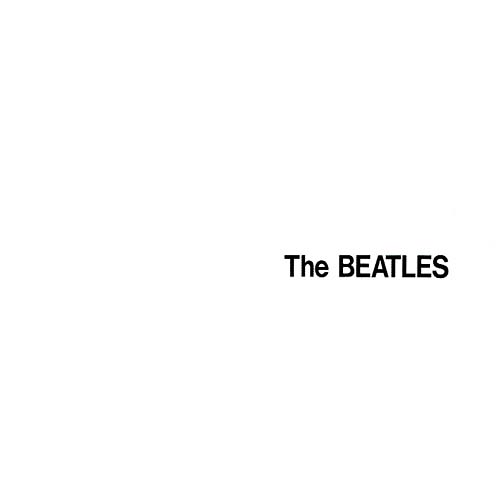
The Beatles (White Album) (1968)

Disc One
1.Back In The U.S.S.R.
2.Dear Prudence
3.Glass Onion
4.Ob-La-Di Ob-La-Da
5.Wild Honey Pie
6.The Continuing Story Of Bungalow Bill
7.While My Guitar Gently Weeps
8.Happiness Is A Warm Gun
9.Martha My Dear
10.I'm So Tired
11.Blackbird
12.Piggies
13.Rocky Raccoon
14.Don't Pass Me By
15.Why Don't We Do It In The Road
16.I Will
17.Julia
Disc Two
1.Birthday
2.Yer Blues
3.Mother Nature's Son
4.Everybody's Got Something To Hide (Except Me and My Monkey)
5.Sexy Sadie
6.Helter Skelter
7.Long Long Long
8.Revolution 1
9.Honey Pie
10.Savoy Truffle
11.Cry Baby Cry
12.Revolution 9
13.Goodnight
By the end of 1968, the unity that once defined the Beatles had largely dissolved into factionalism, with each member increasingly operating as a solo artist in all but name. If Sgt. Pepper was a carefully cultivated artifice of cohesion, The Beatles—forever known as the “White Album”—was its radical inversion: a sprawling, raw, and often disjointed double LP that dared to present the band not as a harmonious whole, but as four divergent voices pulling in different directions.
Even the album’s stark visual identity—a plain white cover embossed only with the band’s name and a serial number—stood in sharp contrast to the technicolor fantasia of its predecessor. That contrast extends deeply into the music. Gone are the thematic conceits, the studio trickery in service of psychedelia. What remains is an unfiltered collage of genres, moods, and experiments, reflecting both the band’s musical range and its internal fragmentation.
There are thirty songs here, some essential, others expendable. That it remains one of their most debated works is no accident. The sheer variety ensures no two listeners will agree on which tracks deserve inclusion, and therein lies its paradox: as a double album, it is too much; as a single, it could have been their best.
McCartney, ever the craftsman, contributes some of the album’s most accessible and polished material. Back in the U.S.S.R. opens the record with ironic bravado, a pastiche of Chuck Berry and the Beach Boys. Birthday and Helter Skelter showcase his capacity for primal rock ’n’ roll, while Martha My Dear and Honey Pie indulge his nostalgia for music hall melodies with varying success. His acoustic turns—Blackbird, I Will, and the slight Why Don’t We Do It in the Road—reveal a fondness for simplicity, though not always profundity. Ob-La-Di, Ob-La-Da, a polarizing reggae-tinged ditty, exemplifies both his gift for melody and his penchant for saccharine excess.
Lennon, by contrast, delivers some of his most intense and esoteric work. Yer Blues is a searing blues parody that doubles as genuine catharsis. Julia, his delicate tribute to his late mother, is arguably his most vulnerable moment on record. The nonsensical brilliance of I Am the Walrus finds a logical continuation in Happiness Is a Warm Gun and The Continuing Story of Bungalow Bill—both eccentric, fragmented compositions that nevertheless hold a dark allure. His most controversial contribution, Revolution 9, is not a song at all but a sound collage, maddening and brave in equal measure. It is frequently derided but represents a bold confrontation with avant-garde abstraction that few mainstream acts would dare attempt.
Harrison, long overshadowed by the Lennon–McCartney machine, contributes four tracks. While My Guitar Gently Weeps, with Eric Clapton lending a solo, is his standout: melancholic, melodic, and finally given the full weight his songwriting deserved. His others—Piggies, Long, Long, Long, and Savoy Truffle—range from satirical to introspective to throwaway, but together mark a continued upward trajectory in his compositional voice. Even Ringo Starr, often relegated to comic relief, contributes his first original song, Don’t Pass Me By. While slight, it is a credible country romp that fits the album’s open-armed eclecticism. He also provides a tender vocal on Good Night, a lullaby from Lennon that closes the album with unexpected sincerity.
The White Album is not flawless. Its flaws, in fact, are part of its identity. The absence of restraint is felt keenly in tracks like Wild Honey Pie, Revolution 9, and others that serve more as curiosities than compositions. But there is genius in the chaos. It captures a band splintering under its own legend, refusing to edit themselves, and in doing so, producing something more human, if less perfect.
That the Beatles could be so uncompromisingly individual yet still function—even nominally—as a group is perhaps the White Album’s greatest mystery. Its incoherence is its coherence. It is not their best album, but it may be their most revealing.
Go Back To The Main Page
Go To Next Review